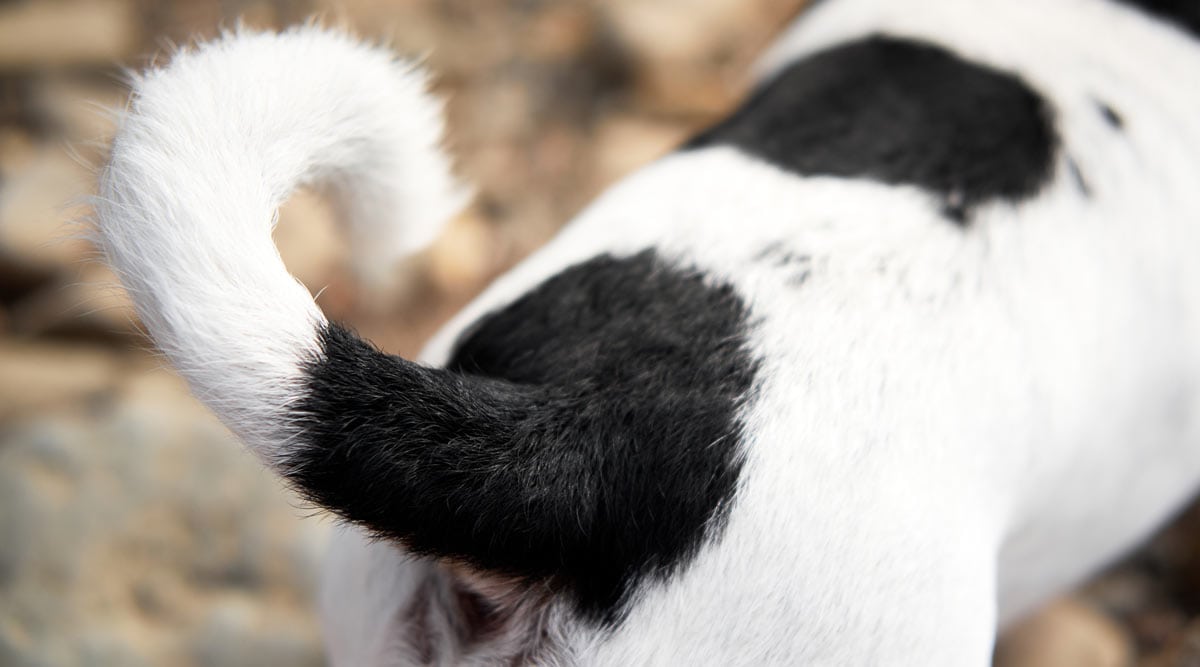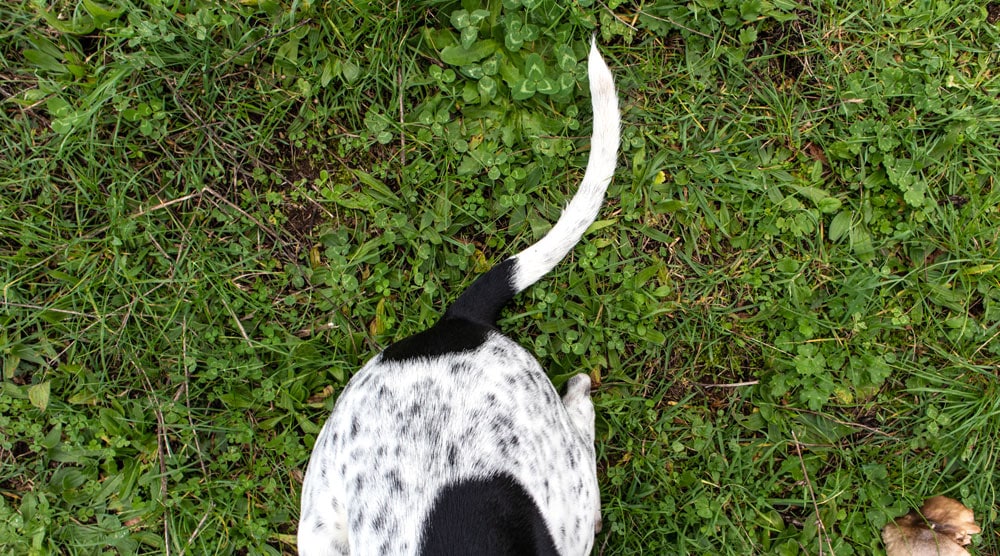Happy tail syndrome might sound like a joyful condition, but it’s a serious and painful issue for dogs. It occurs when a dog’s tail repeatedly strikes hard surfaces, causing skin cracks, wounds and bleeding.
In this guide, we’ll discuss why happy tail syndrome happens and the common symptoms. We’ll also explore some potential treatments and how to reduce the chance of a recurrence.
Important: You should always visit a vet if you suspect your dog has happy tail syndrome (or any other illness). The sooner your dog gets treatment, the better the chance of a positive outcome.
Contents
What Is Happy Tail Syndrome in Dogs?
Happy tail syndrome is a painful condition that can be difficult to treat. It occurs when a dog’s tail frequently slaps against hard objects, such as walls, furniture, or crates.
Typically, the constant hitting against hard surfaces can lead to cracks, wounds, and even bleeding, mostly at the tail’s tip. Given dogs’ natural habit of wagging their tails, these injuries can worsen over time, causing pain and discomfort.
Some common risk factors for this condition include:
- Dog breeds with thin and strong tails, like greyhounds or German shepherds.
- Dog breeds with short hair that doesn’t provide much natural padding.
- Dogs that often experience high levels of excitement, arousal, or stress. These dogs may wag their tails more vigorously.
- Environmental factors, such as living in small spaces or kennels.
It’s worth noting that any dog that frequently wags its tail against hard objects can suffer from happy tail though.
What Damage Can This Problem Cause?
Despite its cheerful name, happy tail syndrome can cause serious injury and pain.
The tail consists of 5 to 23 vertebrae, covered by a thin layer of skin and packed with blood vessels and nerve endings. There is little natural cushioning to the tail, so wounds can develop quite easily. Cuts and scrapes also don’t need to be very deep to become extremely sensitive or bleed a lot.
The damage from happy tail syndrome can range from skin cracks and bruises to larger wounds, which can become infected. If the condition persists for a long time, it can also lead to nerve damage. Although it’s not directly life-threatening, happy tail syndrome can significantly affect a dog’s quality of life.
Additionally, dogs instinctively wag their tails even when it’s painful. It’s common for the syndrome to get progressively worse, as the dog will continue to hit the wounded tail against hard surfaces.
Common Symptoms of Happy Tail Syndrome
Bleeding from the tail is often the first noticeable symptom of happy tail syndrome. A bleeding tail will often fling blood around the house, which can be a very worrying sign!
You may also notice visible wounds to the tail. These can include scratches, bald spots, or, in more serious instances, open wounds.
Dogs with this condition also show signs of discomfort. You might hear your furry friend whine, yelp, or react in pain when their tail is touched or moved. Some dogs, trying to soothe their discomfort, may chew or bite their own tail, which can worsen the injuries.
In severe cases of happy tail syndrome, the damage might cause a broken vertebrae in the tail. Additionally, untreated wounds may lead to infections, causing pus, foul smells, and swelling in the skin around the wound.
Here’s a summary of symptoms to look out for:
- Wounds on the tail, ranging from small cuts to larger open wounds
- Bleeding from the tail
- Bald spots or hair loss on the tail
- Dog chewing or biting at its own tail
- Whining, whimpering, or other vocalizations indicating discomfort
- A reluctance to have the tail touched or moved
How Veterinarians Diagnose Happy Tail Syndrome in Dogs
A diagnosis of happy tail syndrome is generally based on visible symptoms. Your veterinarian will conduct a thorough physical examination of your dog’s tail, looking for wounds, swelling, or any other abnormalities.
Beyond the physical examination, your vet will ask about your dog’s living conditions and behaviors. They may want to know if your dog has been wagging its tail more vigorously than usual or hitting its tail against hard surfaces frequently.
In some instances, the vet might take a test sample to rule out certain medical issues. Similarly, they may recommend blood tests to check for low iron levels, clotting issues, or other conditions that could be contributing to the problem.
What Are The Treatments for Happy Tail Syndrome?
Treating happy tail syndrome can be a challenge, because our furry friends just can’t resist wagging their tails! This wagging often leads to re-injury of the wounds, making the healing process slower and more difficult.
The sooner a dog starts treatment, the better the chance that the wounds heal. Sadly, some dogs need to have part of their tail amputated to prevent further damage, but this is a last resort.
Tail Bandages and Protective Gear
Your vet will likely start the treatment by bandaging the wounded area of the tail, using a breathable bandage to allow for air circulation. To provide additional protection, they might add padding to absorb some of the impact when your dog wags their tail.
These bandages usually need to be changed regularly, so ask your vet to demonstrate how to do this safely at home.
Most dogs don’t enjoy wearing bandages. So, to prevent your dog biting it off, an Elizabethan collar (the “cone of shame”) might be necessary.
Sedatives
In addition to bandages, your vet might prescribe sedatives to keep your dog calm. The goal is to limit vigorous tail wagging during the healing process.
These sedatives may need to be given for several weeks while the wound heals.
Antibiotics and Anti-Inflammatories
If there’s a risk of the wound getting infected, your vet may prescribe antibiotics. Although antibiotics can’t cure happy tail syndrome, they can be important for preventing secondary infections.
Anti-inflammatories may also be prescribed to help reduce swelling in the tail and make your dog more comfortable.
In addition to these treatments, supplemental therapies can help soothe symptoms. Topical vitamin A creams, for instance, may prevent the tail from cracking. Always discuss these additional treatments with your vet first.
Laser Therapy
Laser therapy can be a non-invasive way to speed up the wound healing process and reduce pain.
It works by promoting blood flow to the wounded area, thereby stimulating cell regeneration processes. It’s a painless and safe procedure, making it an attractive choice for dogs with skin wounds.
The downside is that it usually requires multiple sessions to make a noticeable difference to the wound, which can be costly. However, if your vet offers laser therapy, it’s worth discussing whether it would be an effective option.
Surgery or Tail Amputation
When happy tail syndrome is severe, or doesn’t improve with other treatments, surgical intervention may be necessary.
For example, in cases where the wounds are deep, your vet may need to stitch the wounds under anesthesia. This increases the chances of successful healing.
Unfortunately, some dogs with happy tail syndrome require a partial or full tail amputation. This is a last resort when other treatments haven’t worked, or if there is severe damage to the tail.
Dogs use their tails for balance and communication, so the decision to amputate should never be taken lightly. However, in some cases it is the only option.
How to Prevent Happy Tail Syndrome
Happy tail syndrome should always be treated by a vet. However, you can still take steps to reduce tail impacts and lower the chance of it recurring in the future.
Behavior Modification
Stress, anxiety, and over-arousal are all factors that can contribute to the vigorous tail wagging. While it’s unrealistic (and unfair) to try to train your dog not to wag their tail, there are other ways to manage their excitement levels.
By using positive reinforcement and desensitisation methods, you can help your furry friend cope with high-arousal situations. Training alternative cues can also be beneficial when your dog gets excited. For instance, if your dog responds reliably to a “sit” cue, it might help keep their tail from hitting hard objects.
For such training, it’s a good idea seek the help of a professional dog trainer or a canine behaviorist.
Avoiding Over-Excitement
Try to reduce situations that could overly excite your dog, as these could trigger excessive tail wagging. This may involve limiting their exposure to certain triggers, such as other dogs or visitors.
You may need to adjust your own behavior as well. For instance, remaining calm when you return home from being out, instead of greeting your pet with high energy, can prevent over-excitement.
Rearrange Your Furniture
Creating a tail-friendly environment can be as simple as rearranging your furniture. Giving your dog more space to move around without hitting their tail on hard objects can make a world of difference.
Ensure that there are no hard objects at your dog’s tail height. If your dog sleeps in a crate, make sure it’s big enough for them to move comfortably without their tail constantly hitting the sides.
Frequently Asked Questions
Is Happy Tail Painful?
Yes, happy tail syndrome can be very painful for dogs. The level of pain usually depends on how severe the injury is. An infection of the wound can also cause intense pain and discomfort.
Does Tail Wagging Always Mean a Happy Dog?
Not always. While tail wagging is often a sign of happiness or excitement, it can also indicate other emotions such as anxiety, fear, or defensiveness. Read our guide to why dogs wag their tails for more information.
Will Happy Tail Heal on Its Own?
There is no guarantee that happy tail syndrome will heal naturally. Even minor wounds might get worse over time if the right treatment isn’t provided. For these reasons, you should always seek veterinary care if you notice wounds, bleeding, cracking, or bald patches on your dog’s tail.
Which Breeds Are Most Prone to Happy Tail Syndrome?
Happy tail syndrome typically affects breeds that have long, strong, and thin tails. The longer a dog’s tail is, the more likely it is to strike nearby objects and cause an injury.
Some examples of breeds more prone to happy tail syndrome include:
- Great Danes
- Labrador Retrievers
- Golden Retrievers
- Dobermans
- Greyhounds
- Boxers
- German Shepherds
However, it’s important to note that any breed could potentially develop happy tail syndrome given the right conditions.
Summary
Happy tail syndrome is a painful condition in dogs that occurs when their tails repeatedly hit hard surfaces. It’s characterized by tail damage, bleeding, and noticeable discomfort.
It’s important to seek veterinary help if you notice signs of happy tail syndrome. Wounds often get worse when a dog has this condition, so it becomes progressively harder to treat over time.




